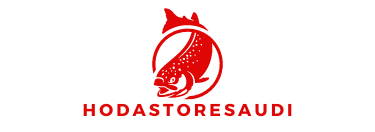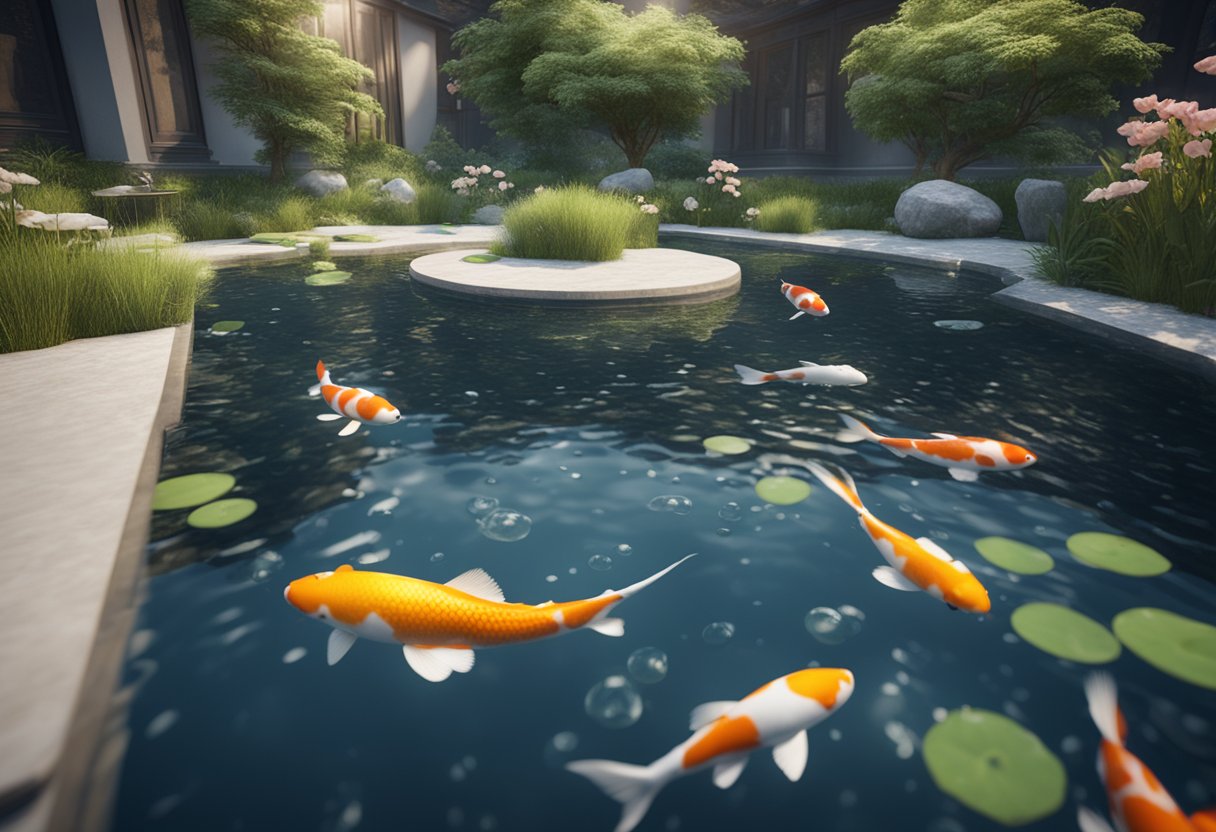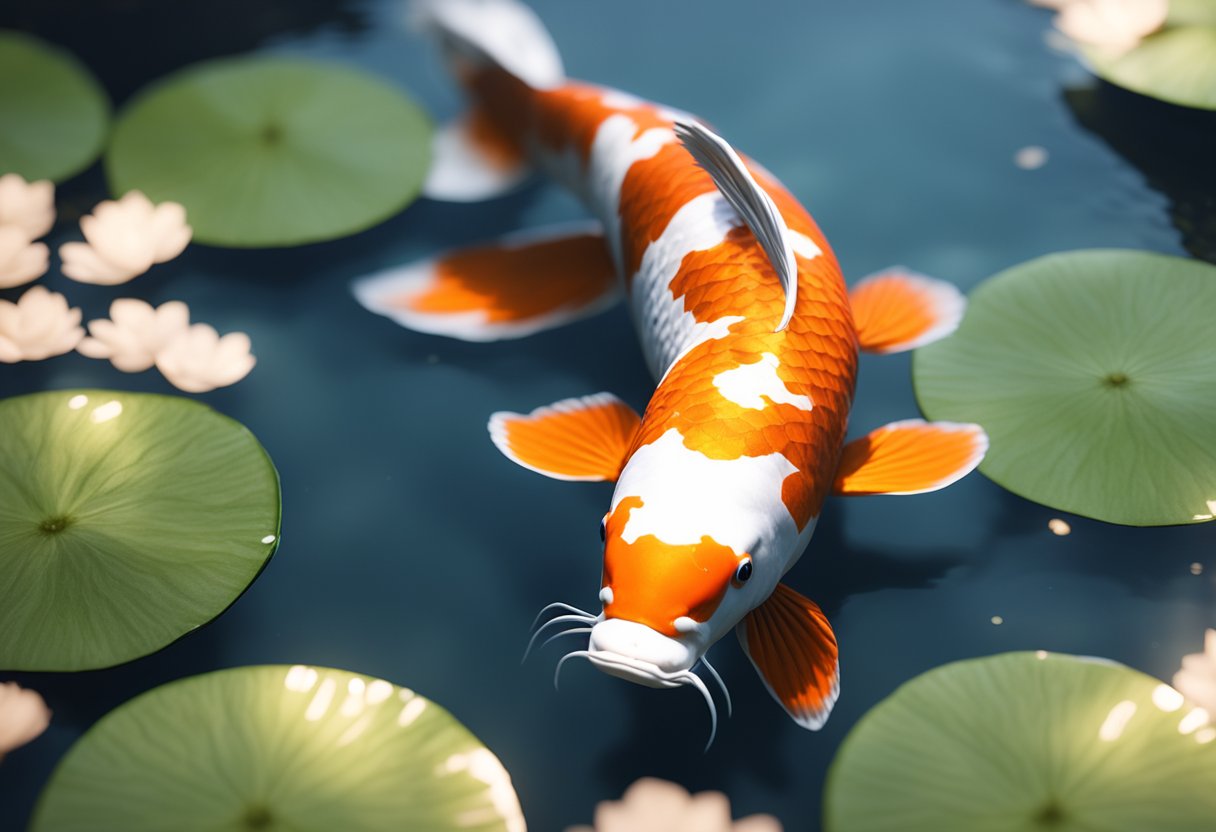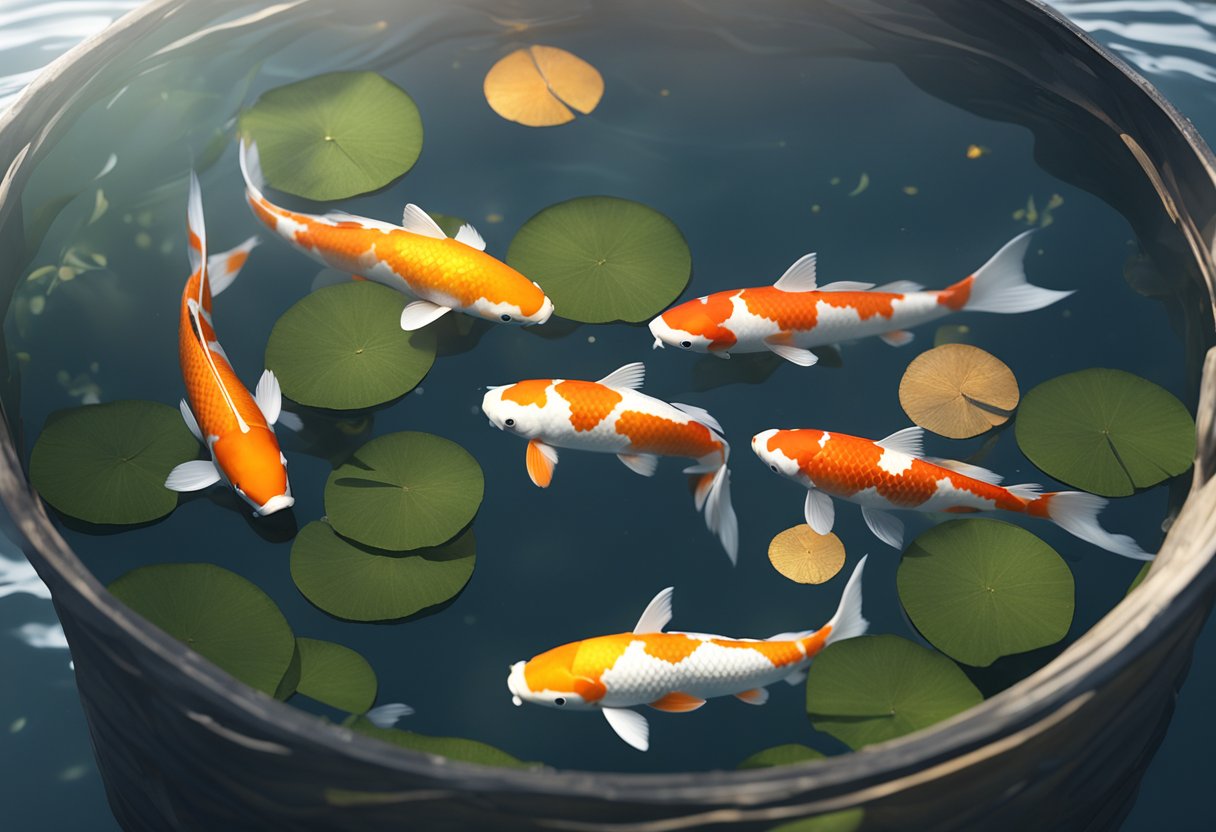Koi Feeding Tips for Healthier Pond Fishes
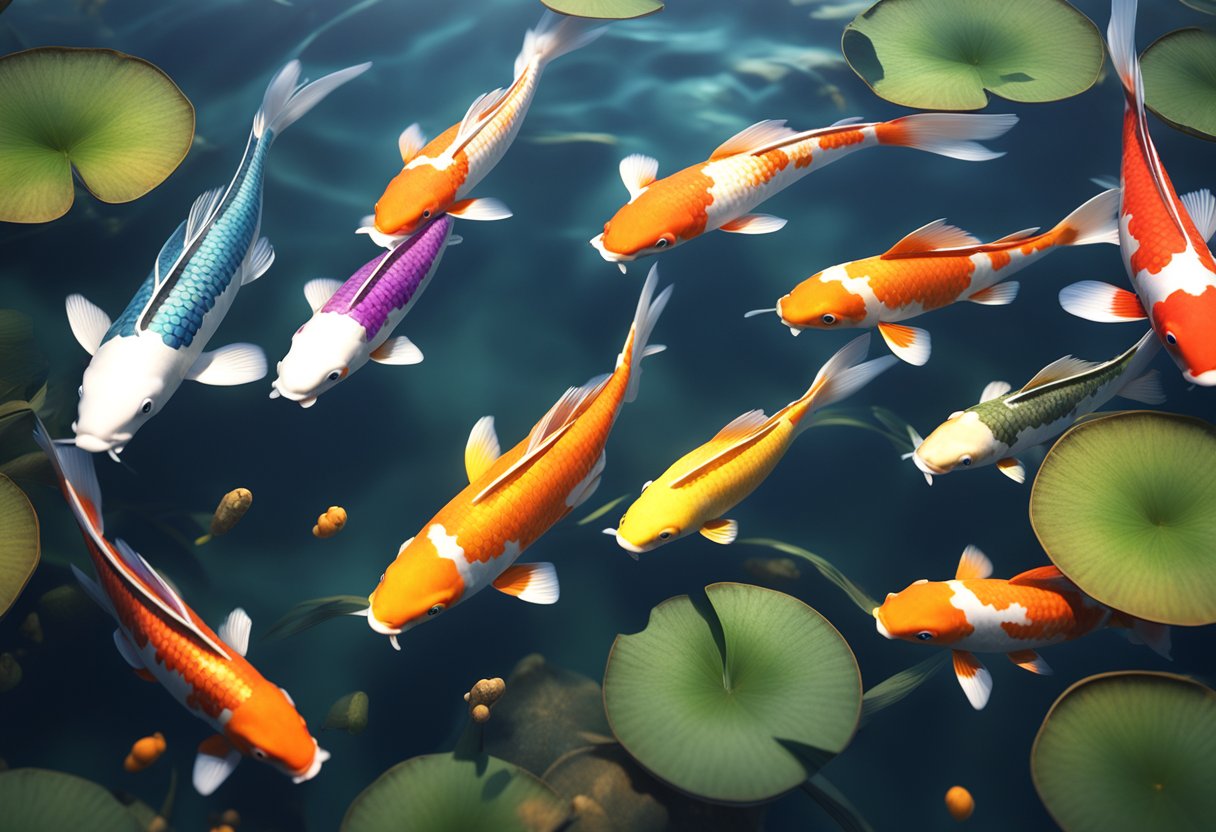
| Feeding Tips for Koi in Winter | Do’s | Don’ts |
|---|---|---|
| Monitor water temperature | ⚫ Regularly check the water temperature using a reliable thermometer | ❌ Rely solely on external weather conditions to determine feeding frequency |
| Feed less frequently | ⚫ Adjust feeding frequency to once or twice a week | ❌ Continue feeding multiple times a day |
| Choose an appropriate koi food | ⚫ Select winter koi food with lower protein levels and easily digestible ingredients | ❌ Use regular koi food formulated for warmer months |
| Feed smaller portions | ⚫ Offer small meals that can be consumed within a few minutes | ❌ Provide large amounts of food at once |
| Consider alternative feeding methods | ⚫ Use automatic fish feeders to dispense small portions at set intervals | ❌ Hand-feed or rely solely on manual feeding |
Feeding Koi in Summer
In the summer months, the warmer temperatures bring about increased metabolism and activity levels in your beloved koi fish. As a responsible koi owner, it’s crucial to adjust their feeding schedule and meet their heightened nutritional needs during this season. Let’s explore some valuable tips and tricks to ensure the health and vitality of your koi during the summer season.
1. Increase Feeding Frequency
With the increased activity of your koi in the summer, it’s important to provide them with regular meals to fuel their energy levels. Increase the frequency of feeding to accommodate their higher metabolic rate, offering them adequate nutrition throughout the day.
2. Monitor Quantity
While it’s essential to meet their increased nutritional requirements, it’s equally important to avoid overfeeding your koi. Remember to monitor the quantity of food provided, ensuring they consume their meals entirely within a few minutes without any leftovers. Overfeeding can lead to various health issues and water quality problems in your pond.
3. Offer Balanced Nutrition
Your koi’s well-being depends on a balanced diet that includes all the necessary nutrients. During the summer, consider supplementing their staple pellets with fresh vegetables and fruits. This provides essential vitamins and minerals to support their immune system and maintain vibrant colors.
4. Consider Treats in Moderation
Treats such as mealworms and shrimp can be a delightful addition to your koi’s summer diet. However, it’s crucial to offer treats in moderation and as occasional rewards. These treats should not replace their staple diet of high-quality koi food.
5. Optimal Feeding Time
Plan your feeding sessions during cooler parts of the day, such as early morning or late evening. Avoid feeding your koi during the hottest part of the day, as this can contribute to heat stress and potentially harm their health.
6. Maintain Water Quality
The summer heat can cause water temperatures to rise, leading to decreased oxygen levels. Adequate aeration and regular water testing become even more critical during this season to ensure optimal water quality for your koi’s health and wellbeing.
Remember, a happy and healthy koi fish is a result of mindful feeding practices and a well-maintained pond environment.
By following these feeding tips, you can ensure that your koi fish thrive and enjoy the summer season to the fullest. Providing them with the right nutrition, adjusting feeding schedules, and maintaining water quality are key elements in creating a harmonious ecosystem for your pond.
| Feeding Tips for Koi in Summer | |
|---|---|
| Increase feeding frequency | Offer regular meals to meet their heightened metabolic rate |
| Monitor quantity | Avoid overfeeding and ensure they finish their meals within a few minutes |
| Provide balanced nutrition | Supplement their diet with fresh vegetables and fruits |
| Consider treats in moderation | Add occasional treats like mealworms and shrimp |
| Optimal feeding time | Plan feeding sessions during cooler parts of the day |
| Maintain water quality | Adequate aeration and regular testing for optimal water conditions |
Feeding Koi Pellets
Koi pellets are a popular choice for feeding pond fish due to their convenience and nutritional benefits. In this section, we will explore the advantages of feeding koi pellets, provide guidance on choosing the best options, and teach you proper feeding techniques to ensure your koi receive all the necessary nutrients.
The Benefits of Feeding Koi Pellets
Feeding koi pellets offers several advantages for both fish owners and their finned friends. These benefits include:
- Complete nutrition: High-quality koi pellets are formulated to provide a balanced diet, containing essential proteins, fats, vitamins, and minerals that promote healthy growth and vibrant colors in your koi fish.
- Easy portion control: Pellets come in various sizes, allowing you to control the amount of food your koi receives. This helps prevent overfeeding and maintains water quality in your pond.
- Reduced waste: Unlike live or frozen foods, koi pellets are easily consumed by your fish, minimizing uneaten food that can contribute to water pollution and algae growth.
- Convenience: Pellets are readily available at pet stores and online retailers, making them a convenient option for regular feeding. They can also be stored for long periods without spoiling.
Choosing the Right Koi Pellets
When selecting the best koi pellets for your fish, consider the following factors:
- Size: Choose pellets that match the size of your koi’s mouth. This ensures easy consumption and prevents choking hazards.
- Nutritional Composition: Look for pellets with a balanced nutritional profile that aligns with the specific needs of your koi fish. Consider the protein content, as a higher percentage is generally beneficial, especially for young and growing koi.
- Ingredients: Check the ingredients list for high-quality, easily digestible ingredients such as fish meal, shrimp, and spirulina. Avoid pellets with excessive fillers or artificial additives.
- Brand Reputation: Choose pellets from reputable brands that prioritize the health and well-being of koi. Research customer reviews and seek recommendations from experienced koi keepers for reliable options.
Proper Techniques for Feeding Koi Pellets
To ensure your koi get the most out of their pellet diet, follow these feeding techniques:
Start by feeding your koi small amounts of pellets, gradually increasing the portion size as they grow. Avoid overfeeding, as it can lead to health issues and poor water conditions. Monitor your fish closely during feeding to ensure they consume all the pellets within a few minutes. Any leftover food should be promptly removed to maintain water quality.
| Koi Pellet Feeding Tips | Description |
|---|---|
| Feed small amounts | Start with a small portion and adjust based on the size and appetite of your koi fish. |
| Feed multiple times a day | Divide the daily portion into several feedings to prevent overeating and ensure proper digestion. |
| Monitor feeding behavior | Observe your koi during feeding to ensure they are actively consuming the pellets and not being outcompeted by other fish. |
| Avoid overfeeding | Remove any uneaten pellets after a few minutes to maintain water quality and prevent waste accumulation. |
By following these techniques, you can optimize the benefits of feeding koi pellets and contribute to the overall health and well-being of your beloved pond fish.
The Importance of Proper Koi Nutrition and Care
Providing proper nutrition and care for your koi fish is crucial for their overall health and longevity. By maintaining a balanced diet that considers factors such as protein content, vitamins, and minerals, you can ensure that your koi fish thrive and remain vibrant in your pond ecosystem.
The Key Elements of Koi Nutrition
To provide optimal nutrition for your koi, it’s important to understand the key elements of their diet. High-quality koi food should contain a balanced blend of protein, vitamins, minerals, and other essential nutrients. **Koi feeding tips** recommend a protein content ranging from 30% to 40%, as this supports their growth and energy needs. Additionally, a variety of vitamins and minerals, such as vitamin C and calcium, helps to boost their immune system and maintain healthy bones.
When choosing koi food, look for reputable brands that prioritize the nutritional needs of your fish. **Koi feeding guide** suggests opting for pellets that are specifically formulated for koi, as these provide complete and balanced nutrition. Avoid feeding your koi fish low-quality food or human foods, as these can cause nutritional deficiencies and health problems.
Feeding Techniques for Optimal Nutrition
Alongside choosing the right food, it’s important to implement proper feeding techniques to ensure your koi fish receive the nutrition they need. **Koi feeding tips** recommend feeding your fish small, frequent meals throughout the day instead of one large meal, which reduces the risk of overfeeding and maintains water quality.
“Proper nutrition is a cornerstone of koi care. By providing a balanced diet and following appropriate feeding techniques, you can support the health and vitality of your koi fish.” – Expert Koi Keeper
Hand-feeding is a popular method that allows you to monitor the feeding process closely and connect with your koi fish. However, if you have a larger pond or need to be away from home, automatic feeders can be a convenient alternative. Ensure that the feeders dispense the proper amount of food and are set to follow your established feeding schedule.
The Role of Water Quality
In addition to nutrition, water quality plays a significant role in the health of your koi fish. **Koi feeding guide** recommends monitoring and maintaining proper water parameters, such as temperature, pH levels, and ammonia levels, as these factors can directly impact your fish’s digestion and overall well-being. Regular water changes, filtration, and keeping the pond clean are essential for the success of your koi feeding regimen.
Achieving a Balanced Koi Diet
To achieve a balanced koi diet, consider incorporating a mix of different food types. Along with pellets, you can supplement your koi’s diet with freeze-dried or frozen foods, such as bloodworms and brine shrimp, to add variety and additional nutrients. However, it’s essential to feed these supplemental foods sparingly and ensure they are safe and suitable for koi consumption.
By prioritizing proper nutrition and care, you can create a thriving environment for your koi fish. With a balanced diet, suitable feeding techniques, and meticulous attention to water quality, your koi will grow, thrive, and contribute to the beauty and tranquility of your pond.
Conclusion
Implementing these koi feeding tips and guidelines is crucial for maintaining the vibrancy and health of your pond fish. By establishing a proper feeding schedule and selecting the best koi food options, you can ensure that your koi fish receive the necessary nutrition for their specific needs and the changing seasons. Feeding them properly, utilizing techniques such as hand-feeding or automatic feeders, will minimize waste and promote optimal growth.
Feeding koi in winter requires adjusting your routine to accommodate colder temperatures and reduced activity levels, while summer feeding should meet their increased metabolic demands. Additionally, koi pellets offer convenience and balanced nutrition, allowing your fish to obtain essential nutrients. Proper nutrition and care contribute to the overall well-being of your koi, helping them thrive and maintaining a beautiful pond ecosystem.
In conclusion, follow these tips to ensure your pond fish flourish. Establish a feeding schedule, select appropriate koi food, and feed your fish accordingly. By providing optimal nutrition and care, your koi fish will remain vibrant, healthy, and a delight to observe in your pond.
